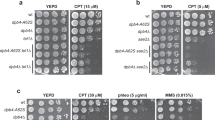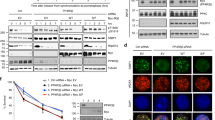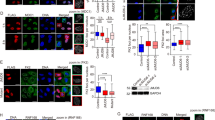Abstract
DNA double-stranded breaks (DSBs) elicit a checkpoint response that causes a delay in cell cycle progression. Early in the checkpoint response, histone H2AX is phosphorylated in the chromatin region flanking the DSB by ATM/ATR and DNA-PK kinases. The resulting foci of phosphorylated H2AX (γ-H2AX) serve as a platform for recruitment and retention of additional components of the checkpoint-signaling cascade that enhance checkpoint signaling and DSB repair. Upon repair, both the assembled protein complexes and the chromatin modifications are removed to quench the checkpoint signal. In this study, we show that the DNA damage-responsive Wip1 phosphatase is bound to chromatin. Moreover, Wip1 directly dephosphorylates γ-H2AX and cells depleted of Wip1 fail to dephosphorylate γ-H2AX during checkpoint recovery. Conversely, premature activation of Wip1 leads to displacement of MDC1 from damage foci and prevents activation of the checkpoint. Taken together, our data show that Wip1 has an essential role in dephosphorylation of γ-H2AX to silence the checkpoint and restore chromatin structure once DNA damage is repaired.
This is a preview of subscription content, access via your institution
Access options
Subscribe to this journal
Receive 50 print issues and online access
$259.00 per year
only $5.18 per issue
Buy this article
- Purchase on Springer Link
- Instant access to full article PDF
Prices may be subject to local taxes which are calculated during checkout




Similar content being viewed by others
References
Bartek J, Bartkova J, Lukas J . (2007). DNA damage signalling guards against activated oncogenes and tumour progression. Oncogene 26: 7773–7779.
Bartek J, Lukas J . (2007). DNA damage checkpoints: from initiation to recovery or adaptation. Curr Opin Cell Biol 19: 238–245.
Bassing CH, Suh H, Ferguson DO, Chua KF, Manis J, Eckersdorff M et al. (2003). Histone H2AX: a dosage-dependent suppressor of oncogenic translocations and tumors. Cell 114: 359–370.
Batchelor E, Mock CS, Bhan I, Loewer A, Lahav G . (2008). Recurrent initiation: a mechanism for triggering p53 pulses in response to DNA damage. Mol Cell 30: 277–289.
Belova G, Demidov ON, Fornace AJ, Bulavin DV . (2005). Chemical inhibition of Wip1 phosphatase contributes to suppression of tumorigenesis. Cancer Biol Ther 4: 1154–1158.
Berkovich E, Monnat RJ, Kastan MB . (2007). Roles of ATM and NBS1 in chromatin structure modulation and DNA double-strand break repair. Nat Cell Biol 9: 683–690.
Block WD, Merkle D, Meek K, Lees-Miller SP . (2004). Selective inhibition of the DNA-dependent protein kinase (DNA-PK) by the radiosensitizing agent caffeine. Nucl Acids Res 32: 1967–1972.
Brummelkamp TR, Bernards R, Agami R . (2002). Stable suppression of tumorigenicity by virus-mediated RNA interference. Cancer Cell 2: 243–247.
Bulavin DV, Phillips C, Nannenga B, Timofeev O, Donehower LA, Anderson CW et al. (2004). Inactivation of the Wip1 phosphatase inhibits mammary tumorigenesis through p38 MAPK-mediated activation of the p16(Ink4a)-p19(Arf) pathway. Nat Genet 36: 343–350.
Canman CE, Lim D-S, Cimprich KA, Taya Y, Tamai K, Sakaguchi K et al. (1998). Activation of the ATM kinase by ionizing radiation and phosphorylation of p53. Science 281: 1677–1679.
Castellino R, De Bortoli M, Lu X, Moon S-H, Nguyen T-A, Shepard M et al. (2008). Medulloblastomas overexpress the p53-inactivating oncogene WIP1/PPM1D. J Neurooncol 86: 245–256.
Celeste A, Difilippantonio S, Difilippantonio MJ, Fernandez-Capetillo O, Pilch DR, Sedelnikova OA et al. (2003a). H2AX haploinsufficiency modifies genomic stability and tumor susceptibility. Cell 114: 371–383.
Celeste A, Fernandez-Capetillo O, Kruhlak MJ, Pilch DR, Staudt DW, Lee A et al. (2003b). Histone H2AX phosphorylation is dispensable for the initial recognition of DNA breaks. Nat Cell Biol 5: 675–679.
Chowdhury D, Keogh M-C, Ishii H, Peterson CL, Buratowski S, Lieberman J . (2005). gamma-H2AX dephosphorylation by protein phosphatase 2A facilitates DNA double-strand break repair. Mol Cell 20: 801–809.
Chowdhury D, Xu X, Zhong X, Ahmed F, Zhong J, Liao J et al. (2008). A PP4-phosphatase complex dephosphorylates gamma-H2AX generated during DNA replication. Mol Cell 31: 33–46.
Chuman Y, Kurihashi W, Mizukami Y, Nashimoto T, Yagi H, Sakaguchi K . (2009). PPM1D430, a novel alternative splicing variant of the human PPM1D, can dephosphorylate p53 and exhibits specific tissue expression. J Biochem 145: 1–12.
Daniel JA, Pellegrini M, Lee J-H, Paull TT, Feigenbaum L, Nussenzweig A . (2008). Multiple autophosphorylation sites are dispensable for murine ATM activation in vivo. J Cell Biol 183: 777–783.
Dinant C, de Jager M, Essers J, van Cappellen WA, Kanaar R, Houtsmuller AB et al. (2007). Activation of multiple DNA repair pathways by sub-nuclear damage induction methods. J Cell Sci 120: 2731–2740.
Doil C, Mailand N, Bekker-Jensen S, Menard P, Larsen DH, Pepperkok R et al. (2009). RNF168 binds and amplifies ubiquitin conjugates on damaged chromosomes to allow accumulation of repair proteins. Cell 136: 435–446.
Downs JA, Lowndes NF, Jackson SP . (2000). A role for Saccharomyces cerevisiae histone H2A in DNA repair. Nature 408: 1001–1004.
Fiscella M, Zhang H, Fan S, Sakaguchi K, Shen S, Mercer WE et al. (1997). Wip1, a novel human protein phosphatase that is induced in response to ionizing radiation in a p53-dependent manner. Proc Natl Acad Sci USA 94: 6048–6053.
Foster E, Downs J . (2005). Histone H2A phosphorylation in DNA double-strand break repair. FEBS J 272: 3231–3240.
Fujimoto H, Onishi N, Kato N, Takekawa M, Xu XZ, Kosugi A et al. (2006). Regulation of the antioncogenic Chk2 kinase by the oncogenic Wip1 phosphatase. Cell Death Differ 13: 1170–1180.
Goodarzi A, Jonnalagadda J, Douglas P, Young D, Ye R, Moorhead G et al. (2004). Autophosphorylation of ataxia-telangiectasia mutated is regulated by protein phosphatase 2A. EMBO J 23: 4451–4461.
Goodarzi AA, Noon AT, Deckbar D, Ziv Y, Shiloh Y, Löbrich M et al. (2008). ATM signaling facilitates repair of DNA double-strand breaks associated with heterochromatin. Molecular Cell 31: 167–177.
Halazonetis TD, Gorgoulis VG, Bartek J . (2008). An oncogene-induced DNA damage model for cancer development. Science 319: 1352–1355.
Harrison M, Li J, Degenhardt Y, Hoey T, Powers S . (2004). Wip1-deficient mice are resistant to common cancer genes. Trends Mol Med 10: 359–361.
Heo K, Kim H, Choi SH, Choi J, Kim K, Gu J et al. (2008). FACT-mediated exchange of histone variant H2AX regulated by phosphorylation of H2AX and ADP-ribosylation of Spt16. Mol Cell 30: 86–97.
Hickson I, Zhao Y, Richardson CJ, Green SJ, Martin NMB, Orr AI et al. (2004). Identification and characterization of a novel and specific inhibitor of the ataxia-telangiectasia mutated kinase ATM. Cancer Res 64: 9152–9159.
Kalejta RF, Shenk T, Beavis AJ . (1997). Use of a membrane-localized green fluorescent protein allows simultaneous identification of transfected cells and cell cycle analysis by flow cytometry. Cytometry 29: 286–291.
Keogh M-C, Kim J-A, Downey M, Fillingham J, Chowdhury D, Harrison JC et al. (2006). A phosphatase complex that dephosphorylates gammaH2AX regulates DNA damage checkpoint recovery. Nature 439: 497–501.
Lee J-H, Paull TT . (2005). ATM activation by DNA double-strand breaks through the Mre11-Rad50-Nbs1 complex. Science 308: 551–554.
Lee JH, Paull TT . (2007). Activation and regulation of ATM kinase activity in response to DNA double-strand breaks. Oncogene 26: 7741–7748.
Li J, Yang Y, Peng Y, Austin RJ, van Eyndhoven WG, Nguyen KCQ et al. (2002). Oncogenic properties of PPM1D located within a breast cancer amplification epicenter at 17q23. Nat Genet 31: 133–134.
Lindqvist A, de Bruijn M, Macurek L, Bras A, Mensinga A, Bruinsma W et al. (2009). Wip1 confers G2 checkpoint recovery competence by counteracting p53-dependent transcriptional repression. EMBO J 28: 3196–3206.
Lindqvist A, van Zon W, Karlsson Rosenthal C, Wolthuis RMF . (2007). Cyclin B1-Cdk1 activation continues after centrosome separation to control mitotic progression. PLoS Biology 5: e123.
Lu X, Bocangel D, Nannenga B, Yamaguchi H, Appella E, Donehower LA . (2004). The p53-induced oncogenic phosphatase PPM1D interacts with uracil DNA glycosylase and suppresses base excision repair. Mol Cell 15: 621–634.
Lu X, Ma O, Nguyen T-A, Jones SN, Oren M, Donehower LA . (2007). The Wip1 Phosphatase acts as a gatekeeper in the p53-Mdm2 autoregulatory loop. Cancer Cell 12: 342–354.
Lu X, Nannenga B, Donehower L . (2005). PPM1D dephosphorylates Chk1 and p53 and abrogates cell cycle checkpoints. Genes Dev 19: 1162–1174.
Lu X, Nguyen T, Moon S, Darlington Y, Sommer M, Donehower L . (2008). The type 2C phosphatase Wip1: an oncogenic regulator of tumor suppressor and DNA damage response pathways. Cancer Metastasis Rev 27: 123–135.
Macurek L, Lindqvist A, Lim D, Lampson MA, Klompmaker R, Freire R et al. (2008). Polo-like kinase-1 is activated by aurora A to promote checkpoint recovery. Nature 455: 119–123.
Mailand N, Bekker-Jensen S, Faustrup H, Melander F, Bartek J, Lukas C et al. (2007). RNF8 ubiquitylates histones at DNA double-strand breaks and promotes assembly of repair proteins. Cell 131: 887–900.
Nakada S, Chen G, Gingras A, Durocher D . (2008). PP4 is a gamma H2AX phosphatase required for recovery from the DNA damage checkpoint. EMBO Rep 9: 1019–1026.
Pellegrini M, Celeste A, Difilippantonio S, Guo R, Wang W, Feigenbaum L et al. (2006). Autophosphorylation at serine 1987 is dispensable for murine Atm activation in vivo. Nature 443: 222–225.
Petersen P, Chou DM, You Z, Hunter T, Walter JC, Walter G . (2006). Protein phosphatase 2A antagonizes ATM and ATR in a Cdk2- and Cdc7-independent DNA damage checkpoint. Mol Cell Biol 26: 1997–2011.
Reinhardt HC, Yaffe MB . (2009). Kinases that control the cell cycle in response to DNA damage: Chk1, Chk2, and MK2. Curr Opin Cell Biol 21: 245–255.
Rogakou EP, Pilch DR, Orr AH, Ivanova VS, Bonner WM . (1998). DNA double-stranded breaks induce histone H2AX phosphorylation on serine 139. J Biol Chem 273: 5858–5868.
Saito-Ohara F, Imoto I, Inoue J, Hosoi H, Nakagawara A, Sugimoto T et al. (2003). PPM1D is a potential target for 17q gain in neuroblastoma. Cancer Res 63: 1876–1883.
Sarkaria JN, Busby EC, Tibbetts RS, Roos P, Taya Y, Karnitz LM et al. (1999). Inhibition of ATM and ATR kinase activities by the radiosensitizing agent, caffeine. Cancer Res 59: 4375–4382.
Shiloh Y . (2003). ATM and related protein kinases: safeguarding genome integrity. Nat Rev Cancer 3: 155–168.
Shreeram S, Demidov ON, Hee WK, Yamaguchi H, Onishi N, Kek C et al. (2006a). Wip1 phosphatase modulates ATM-dependent signaling pathways. Mol Cell 23: 757–764.
Shreeram S, Hee WK, Demidov ON, Kek C, Yamaguchi H, Fornace Jr AJ et al. (2006b). Regulation of ATM/p53-dependent suppression of myc-induced lymphomas by Wip1 phosphatase. J Exp Med 203: 2793–2799.
Shroff R, Arbel-Eden A, Pilch D, Ira G, Bonner WM, Petrini JH et al. (2004). Distribution and dynamics of chromatin modification induced by a defined DNA double-strand break. Curr Biol 14: 1703–1711.
Stewart GS, Panier S, Townsend K, Al-Hakim AK, Kolas NK, Miller ES et al. (2009). The RIDDLE syndrome protein mediates a ubiquitin-dependent signaling cascade at sites of DNA damage. Cell 136: 420–434.
Stucki M, Clapperton JA, Mohammad D, Yaffe MB, Smerdon SJ, Jackson SP . (2005). MDC1 directly binds phosphorylated histone H2AX to regulate cellular responses to DNA double-strand breaks. Cell 123: 1213–1226.
Svetlova M, Solovjeva L, Nishi K, Nazarov I, Siino J, Tomilin N . (2007). Elimination of radiation-induced gamma-H2AX foci in mammalian nucleus can occur by histone exchange. Biochem Biophys Res Commun 358: 650–654.
Takekawa M, Adachi M, Nakahata A, Nakayama I, Itoh F, Tsukuda H et al. (2000). p53-inducible wip1 phosphatase mediates a negative feedback regulation of p38 MAPK-p53 signaling in response to UV radiation. EMBO J 19: 6517–6526.
Xu X, Stern DF . (2003). NFBD1/KIAA0170 is a chromatin-associated protein involved in DNA damage signaling pathways. J Biol Chem 278: 8795–8803.
Yamaguchi H, Durell SR, Chatterjee DK, Anderson CW, Appella E . (2007). The Wip1 phosphatase PPM1D dephosphorylates SQ/TQ motifs in checkpoint substrates phosphorylated by PI3K-like kinases. Biochemistry 46: 12594–12603.
Acknowledgements
We are thankful to Dr Lukas for providing MDC–EGFP plasmid, Dr Donehower for Wip1–FLAG, Dr Dansen and P Charitou for providing reagents, Livio Kleij for maintenance of the microscopes and Monica Alvarez for critical reading of the article. RHM and LM were funded by the Netherlands Genomics Initiative of NWO and the Dutch Cancer Society (UU2006-3579), LM by Grant Agency of the Czech Republic (P305/10/P420), AL by the Wenner-Gren foundation and by the Netherlands Organization for Scientific Research (NWO) (ZonMw 916.86.083) and HV by the Center for Translational Molecular Medicine (CTMM).
Author information
Authors and Affiliations
Corresponding author
Ethics declarations
Competing interests
The authors declare no conflict of interest.
Additional information
Supplementary Information accompanies the paper on the Oncogene website
Supplementary information
Rights and permissions
About this article
Cite this article
Macůrek, L., Lindqvist, A., Voets, O. et al. Wip1 phosphatase is associated with chromatin and dephosphorylates γH2AX to promote checkpoint inhibition. Oncogene 29, 2281–2291 (2010). https://doi.org/10.1038/onc.2009.501
Received:
Revised:
Accepted:
Published:
Issue Date:
DOI: https://doi.org/10.1038/onc.2009.501
Keywords
This article is cited by
-
Co-targeting WIP1 and PARP induces synthetic lethality in hepatocellular carcinoma
Cell Communication and Signaling (2022)
-
DNA damage response revisited: the p53 family and its regulators provide endless cancer therapy opportunities
Experimental & Molecular Medicine (2022)
-
Truncated PPM1D impairs stem cell response to genotoxic stress and promotes growth of APC-deficient tumors in the mouse colon
Cell Death & Disease (2019)
-
ATR kinase regulates its attenuation via PPM1D phosphatase recruitment to chromatin during recovery from DNA replication stress signalling
Journal of Biosciences (2018)
-
WIP1 phosphatase as pharmacological target in cancer therapy
Journal of Molecular Medicine (2017)



